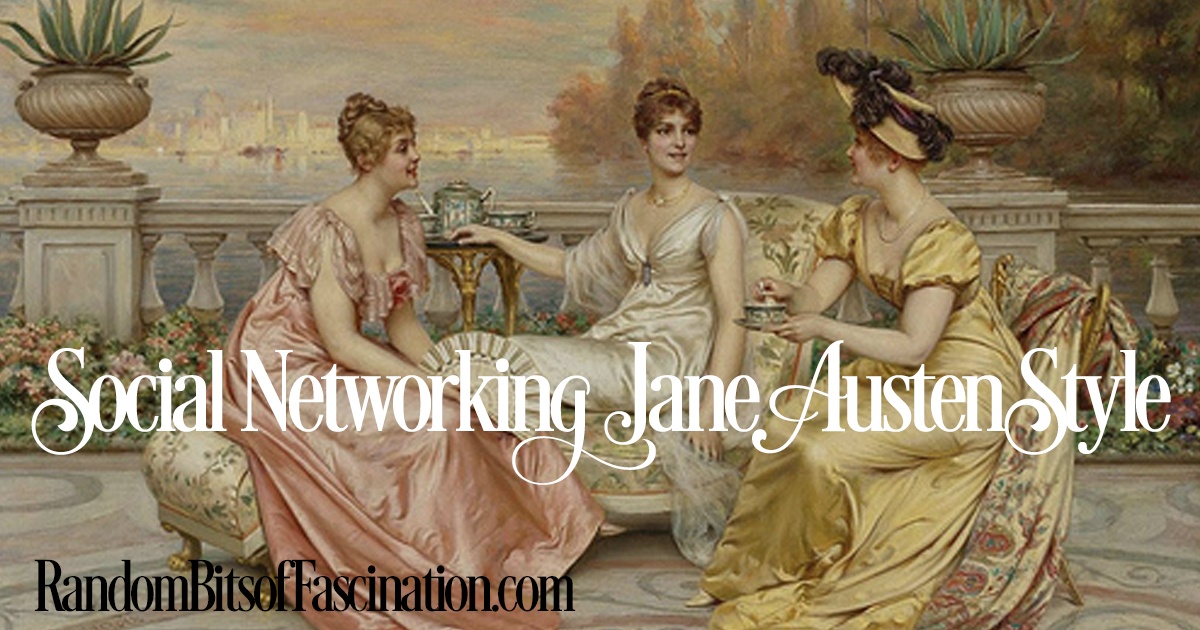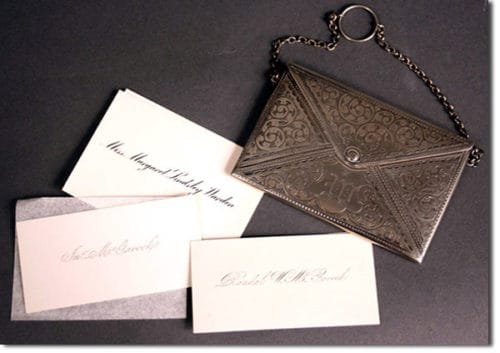Social Networking in the Regency Era

With the advent of social media, social networking has taking on an entirely new set of rules. What were the rules that governed such interactions in Austen’s day?
Of Mixing and Mingling

In the 1800s, the moneyed minority in any locale was expected mix socially with one another, whether or not they were personally agreeable to one another. But there were rules to these interactions. One did not just interact with other people willy-nilly. Thing of the consequences to a lady’s reputation!
In general, people only mixed socially within their own social class, so the company could become confined and unvarying quickly. Hence, new families of the right social standing would quickly be paid an obligatory visit by their neighbors in order to initiate an acquaintance and effectively broaden the social circle.
Formal introductions helped protect women’s reputations, especially those of young ladies. They controlled who might be allowed to interact with said young lady. So, that annoying guy at the grocery store, the one you’ve never seen before but who insists on trying to hold a conversation when all you want to do is buy your chocolate covered chickpeas and get out of there? Well he would be the epitome of all that was improper. You could turn up your nose and walk away. And everyone would say you had done the right and proper thing!
Today one can introduce themselves to a potentially interesting stranger and strike up a conversation. During the regency, proper ladies and gentlemen required a formal introduction by a mutual acquaintance before they could interact. Until a formal acquaintance was recognized, members of the families could not socialize with one another.
Establishing a Formal Acquaintance

When a new family moved into a neighborhood, established members of the neighborhood would take it upon themselves to call upon the newcomers, one of the very few instances when an individual might introduce themselves. There was a bit of a catch though. Only men called upon men, women did not initiate the relationship themselves. Hence Mrs. Bennet’s dismay in Pride and Prejudice when Mr. Bennet refuses to visit Mr. Bingley at Netherfield and establish a formal acquaintance between the families.
Once the man of the house established the acquaintance and performed introductions for the women in his household, they could interact socially and even introduce the newcomers to others. Neighborhood matrons and parsons’ wives, with their wide range of connections, were an excellent source of introductions for newcomers. The Middletons of Austen’s Sense and Sensibility play this role for the Dashwood sisters. No doubt Augusta Elton of Emma would have thoroughly enjoyed this aspect of her position as the vicar’s wife. Public and private events including dinners and parties, feasts, festivals, even wakes, provided opportunities for introductions.
Commonly the social inferior was introduced to the superior, and men to women, rather than the reverse. Unlike in town, where one had to wait for the call of a superior, in the country it was acceptable for a man to make a call or leave a card with someone of higher social standing if that person was new to the neighborhood. Acceptance by those above one’s social status was a key to social mobility in Regency society, so such acquaintances were highly sought after.
Social connections were usually formed through a series of meetings, usually beginning with the leaving of calling cards .
Calling cards
Morning calls or informal visiting upon a household had an established protocol. Those who failed to follow it risked being shunned. First a calling card was presented to the household’s servant.

Calling cards became popular at the end of the 18th century and bore the visitor’s name, title and residence. Their purpose was to prevent errors by forgetful servants. After all, one could not trust one’s social future to a mere servant’s memory.
One would generally leave not a single card, but three: one from the lady for the house’s mistress; one from the gentleman for the house’s mistress and another for the house’s master. Calling cards were displayed on special trays often set up on the front hallways, visible to all who came into the house. Cards from high ranking individuals and titled folks gave additional status to the household displaying their cards.
If one came without a card, he or she might be snubbed. When a servant received the cards, they would be conveyed to the mistress who would then decide whether to admit or reject the caller. If the servant informed the caller that the mistress was ‘not at home’, this was code for not wishing to make the acquaintance. On the other hand, if a reciprocal card was formally presented to the visitor, this indicated there was a chance for the relationship to develop.
If one was uncertain as to the reception one might receive, the safest course would be to leave his or her card without asking if the mistress was at home. This would oblige her to reciprocate the call the next day, if only by leaving her own card. Failure to do so was a rebuff, but certainly a less painful one that being rejected at the door.
Once a calling card ritual had been performed, then social calls might begin. We’ll discuss that in the next post.

Oh, dear, so many rules. I know I’d make a mistake and flub up for sure. I’d be a social outcast within 24-hours of being in town. LOL! I can just see Sir Walter Elliot [poor nan] gleefully peeking out the window as his cousin Lady Dalrymple left her card. Thanks for the post.
I am thoroughly enjoying the artwork included with your posts! Finding the paintings and photos, deciding which will enhance which post, placement–all these things take extra time and are much appreciated along with the accurate information you provide.